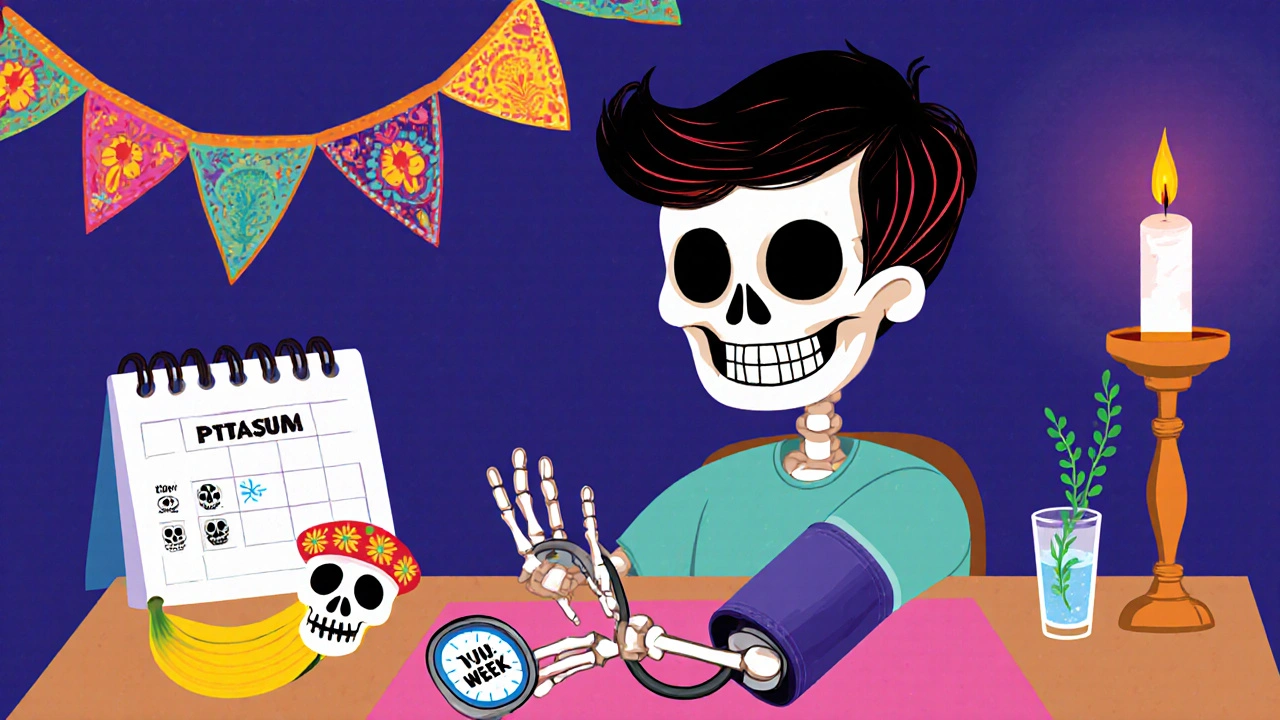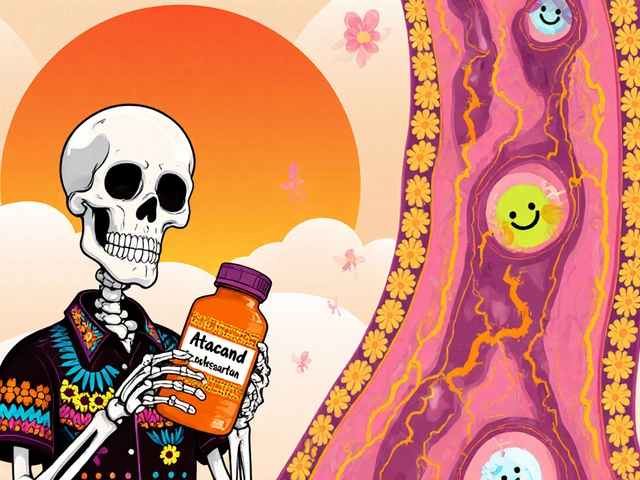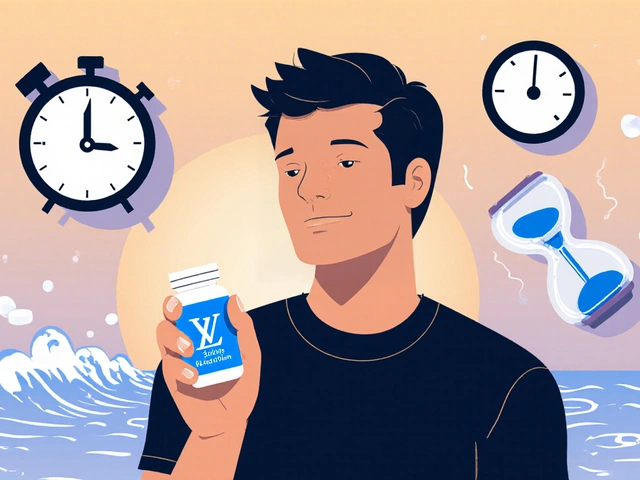Trying to figure out whether Atacand (Candesartan) is the right choice for your blood‑pressure routine? You’re not alone. Millions of patients juggle ARBs, ACE inhibitors, and diuretics every day, and the decision often boils down to small differences in dosage, side‑effects, and how the drug interacts with other meds. This guide breaks down Candesartan, lines it up against the most common alternatives, and gives you a clear picture of when each option shines.
What is Atacand (Candesartan)?
Atacand (Candesartan) is an angiotensin II receptor blocker (ARB) approved for treating hypertension and heart‑failure. Marketed under the brand name Atacand, it blocks the AT‑1 receptor, preventing angiotensin II from narrowing blood vessels.
Since its FDA approval in 1998, Candesartan has become a staple in many treatment plans because it offers once‑daily dosing and a relatively low incidence of cough-a common complaint with ACE inhibitors.
How Candesartan Works
Angiotensin II is a hormone that tightens arteries, raises blood pressure, and triggers fluid retention. By occupying the AT‑1 receptor, Candesartan stops this cascade, allowing vessels to stay relaxed and blood pressure to drop.
Because it works downstream of the renin‑angiotensin system, Candesartan does not interfere with bradykinin levels, which is why fewer patients experience a dry cough compared to ACE inhibitors like Enalapril.
Key Benefits and Common Side Effects
- Once‑daily dosing: Most patients take 8 mg or 16 mg in the morning.
- Effective blood‑pressure reduction: Clinical trials show an average drop of 10‑12 mmHg systolic.
- Kidney‑friendly: Safe for patients with mild‑to‑moderate renal impairment when dose‑adjusted.
Typical side effects include dizziness, hyperkalemia, and occasional headache. Severe reactions such as angio‑edema are rare (<0.2%).

Comparison with Other ARBs
Below is a side‑by‑side look at Candesartan and the most prescribed ARBs. All dosages are standard adult ranges.
| Drug (Generic) | Typical Daily Dose | Half‑Life | Key Advantage | Notable Drawback |
|---|---|---|---|---|
| Candesartan | 8 mg - 16 mg | ~9 hours | Low cough risk | Higher cost than generic Losartan |
| Losartan | 50 mg - 100 mg | ~2 hours (active metabolite 6‑12 hours) | Widely available, cheapest ARB | May require twice‑daily dosing for some patients |
| Valsartan | 80 mg - 320 mg | ~6 hours | Strong evidence in heart‑failure | Potential for higher potassium rise |
| Irbesartan | 150 mg - 300 mg | ~12 hours | Effective for diabetic nephropathy | Can cause mild dizziness at start |
| Telmisartan | 40 mg - 80 mg | ~24 hours | Once‑daily dosing even for severe hypertension | Higher incidence of gastrointestinal upset |
| Olmesartan | 20 mg - 40 mg | ~13 hours | Potent BP drop, good for resistant hypertension | Rare risk of sprue‑like enteropathy |
| Hydrochlorothiazide | 12.5 mg - 25 mg (often combined) | ~6‑15 hours | Added diuretic effect improves control | Can cause electrolyte imbalance |
Key takeaways:
- If you want the lowest chance of a cough, Candesartan wins over ACE inhibitors and many ARBs.
- Losartan remains the budget‑friendly starter, but you might need a split dose.
- Telmisartan’s ultra‑long half‑life suits patients who forget daily pills.
- For patients with diabetic kidney disease, Irbesartan has extra protective data.
When to Choose Candesartan Over Alternatives
- History of ACE‑inhibitor cough: Switch to Candesartan to keep the cough away.
- Stable once‑daily regimen needed: Its half‑life offers consistent coverage without a second dose.
- Renal considerations: Candesartan can be used down to eGFR ≈ 30 mL/min with dose adjustment, whereas some ARBs need tighter monitoring.
- Combination therapy: Often paired with Hydrochlorothiazide in a single pill to boost effect.
If cost is the primary barrier, Losartan or generic Valsartan may be more accessible through insurance formularies. For patients with resistant hypertension, Olmesartan or Telmisartan are worth discussing.

Practical Tips for Patients Starting Candesartan
- Take the tablet with or without food, but try to keep the time consistent each day.
- Check potassium levels after the first month; ARBs can raise serum potassium.
- Monitor blood pressure twice a week for the first two weeks, then weekly until stable.
- If you feel dizzy, rise slowly from sitting or lying positions to avoid falls.
- Inform your doctor about any over‑the‑counter NSAIDs; they may increase kidney risk when combined with Candesartan.
Frequently Asked Questions
Can I take Candesartan with other blood‑pressure meds?
Yes. Candesartan is often combined with a thiazide diuretic such as Hydrochlorothiazide or with a calcium‑channel blocker. Your doctor will tailor the regimen based on your blood‑pressure targets and other health conditions.
Is Candesartan safe during pregnancy?
No. Like all ARBs, Candesartan is classified as pregnancy category D. It can cause fetal kidney injury and should be stopped as soon as pregnancy is detected.
How long does it take to feel the effect?
Blood‑pressure usually begins to drop within 2‑4 hours after the first dose, with the full effect reached after about 2 weeks of consistent use.
What should I do if I miss a dose?
Take the missed tablet as soon as you remember, unless it’s almost time for the next dose. In that case, skip the missed one and continue with your regular schedule-don’t double‑dose.
Are there any foods I should avoid?
There are no strict dietary bans, but a high‑potassium diet (bananas, oranges, potatoes) can amplify the drug’s effect on serum potassium. Talk to your clinician if you plan major diet changes.








8 Comments
Greg Galivan October 25, 2025
If you’re still hoppin on the Atacand hype, you’re missing the real issues-most patients could save a ton of hassle by just picking a generic ACE instead.
Anurag Ranjan November 3, 2025
Candesartan works well for many people its once‑daily dosing makes it easy to remember
James Doyle November 11, 2025
When clinicians evaluate antihypertensive regimens, the pharmacodynamic profile of Candesartan warrants meticulous scrutiny. Its angiotensin II type 1 receptor antagonism confers a mechanistic advantage over upstream renin inhibitors. Moreover, the drug exhibits a half‑life conducive to stable plasma concentrations, thereby minimizing trough‑related spikes. The absence of bradykinin accumulation translates into a markedly reduced cough incidence, a factor frequently cited in comparative meta‑analyses. In renal‑compromised cohorts, dose titration protocols have demonstrated preserved efficacy without exacerbating hyperkalemia. Cardiovascular outcome trials further substantiate its role in attenuating left ventricular hypertrophy, a surrogate marker of morbidity. Economic assessments reveal that generic formulations mitigate cost barriers, enhancing adherence metrics. Contraindications remain limited, predominantly encompassing concurrent use with aliskiren in diabetic patients. Drug‑drug interaction matrices underscore its compatibility with thiazide diuretics, facilitating combination therapy. Patient‑reported outcomes indicate a favorable quality‑of‑life index relative to certain ACE inhibitors. Nonetheless, clinicians must remain vigilant for rare angio‑edema presentations, albeit with an incidence below 0.1%. Pharmacogenomic data suggest variable responsiveness among CYP2C9 polymorphisms, an emerging consideration in precision medicine. Comparative effectiveness research consistently places Candesartan alongside telmisartan and valsartan in the upper efficacy tier. Ultimately, the decision matrix integrates comorbidities, tolerability, and formulary constraints. Therefore, a nuanced, patient‑centered approach remains the cornerstone of optimal antihypertensive selection.
ALBERT HENDERSHOT JR. November 20, 2025
It is commendable that you are delving into the nuances of antihypertensive therapy; a thorough understanding empowers patients to make informed choices 🙂. The comparative framework you provided offers clarity on dosing frequencies and adverse‑event profiles.
Suzanne Carawan November 28, 2025
Oh great, another guide about a drug nobody asked for.
Donal Hinely December 6, 2025
Yo, the “once‑daily” brag is nice but if you’re ignoring the potassium spike risk you’re basically playing roulette with a loaded gun.
christine badilla December 15, 2025
Seriously, I can feel my heart pounding just reading that-if we keep downplaying side effects, we’re setting the stage for a pharmaceutical tragedy!
Every missed warning feels like a scream in the night.
Octavia Clahar December 23, 2025
While the guide is tidy, it glosses over the fact that many insurers still push older ACE inhibitors, making Candesartan a luxury rather than a necessity.